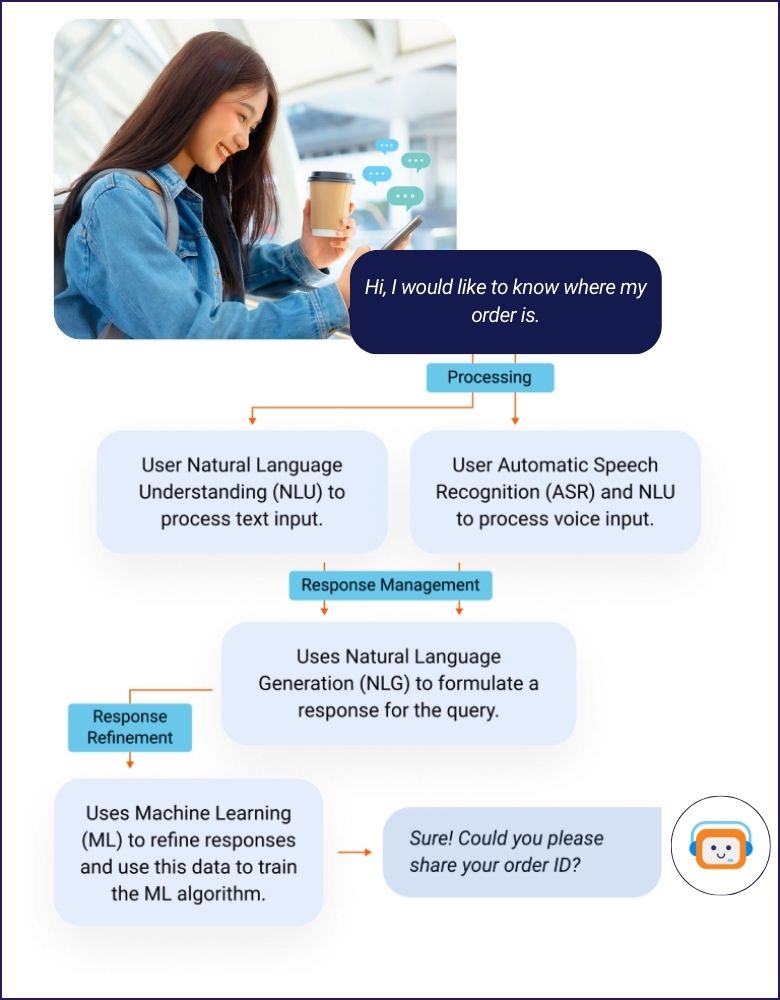In today’s fast-paced digital era, customers expect immediate and accurate responses when they visit your website for information or reach out for support. While chatbots can meet this demand by addressing queries and handling complex questions instantly, their capabilities remain limited.
Conversational AI, powered by Generative AI (Gen-AI), goes well beyond these basic functionalities. With advanced capabilities, it not only stands apart but also proves significantly more effective than traditional chatbots and other automated customer interaction tools.
In this article, we delve into what truly sets Conversational Artificial Intelligence (AI) apart and explore its transformative potential.
Table of Contents
ToggleConversational AI Market Growth
Conversational AI is no longer a niche tool—it’s a booming global market. The demand for AI-driven customer support solutions is skyrocketing, with industries adopting AI to boost engagement and efficiency. According to Gartner, 3% of customer interactions in contact centers were managed by Conversational AI in 2023, a figure projected to climb to 14% by 2027.
For example, Nubitel Conversational AI empowers businesses in retail, healthcare, and finance by enabling seamless customer interactions across channels like web, social media, and messaging apps. The adoption of omnichannel methods has further accelerated the growth of Conversational AI solutions globally.
How Conversational AI Works
At the core of Conversational AI lies a blend of NLP and ML. This combination enables the technology to interpret human language, process context, and respond naturally. Here’s how it functions step-by-step:
- User Input: Customers type or speak their queries.
- Natural Language Understanding (NLU): The AI deciphers intent and extracts relevant details.
- Machine Learning (ML): AI generates a tailored response based on learned patterns.
- Response Delivery: The system delivers replies in text or synthesized speech.

Key Differentiators: Conversational AI vs. Traditional Chatbots
Conversational AI: Advanced and Adaptive
Conversational AI, powered by Natural Language Processing (NLP) and Machine Learning (ML), stands out with its ability to engage in human-like conversations, retain context, and provide personalized recommendations. Unlike chatbots, which rely on rule-based scripts, Conversational AI continuously learns from interactions to improve its responses.
Traditional Chatbots: Limited and Rule-Based
While useful for basic inquiries, chatbots lack the ability to handle complex conversations or adapt over time. They are best suited for straightforward tasks, such as answering FAQs.
| Feature | Conversational AI | Traditional Chatbots |
| Language Understanding | Context-aware, offering human-like dialogue | Limited to rigid, rule-based scripts |
| Learning Capability | Continuously improves through interactions | Static and non-adaptive |
| User Experience | Personalized and natural conversations | Often robotic and impersonal |
| Complexity Handling | Can manage multi-step or layered interactions | Restricted to simple, linear task |
Industries Leading Conversational AI Adoption
Conversational AI is transforming industries, streamlining workflows, and enhancing customer satisfaction. Below are some examples of its impact across different sectors:
| Industry | Pre-Sale | During Sale | Post-Sale |
| E-commerce | Product Recommendations | Order Assistance | Delivery Updates & Feedback |
| Healthcare | Appointment Scheduling | Patient Queries | Post-Consultation Follow-ups |
| Finance | Loan Eligibility Checks | Real-time Support for Transactions | Fraud Alerts & Customer Feedback |
| Travel | Travel Itinerary Suggestions | Booking Assistance | Flight Updates & Support |
Core Components of Conversational AI Systems
Building an effective Conversational AI system requires integrating multiple sophisticated technologies, each playing a pivotal role in creating a seamless and intelligent user experience. Here’s an in-depth look at the key components:
1. Natural Language Understanding (NLU)
NLU is at the heart of Conversational AI, enabling the system to comprehend and interpret user inputs. It deciphers the intent behind a query, identifies key entities, and provides contextual understanding. For instance, in a query like “What’s the weather like in Singapore tomorrow?”, NLU identifies “weather”, “Singapore”, and “tomorrow” as critical elements to generate an accurate response.
2. Machine Learning (ML)
Machine learning drives the adaptability of the AI system. It enables the system to learn from past interactions and improve over time. Through continuous training on data sets, ML helps the system refine its responses, predict user needs, and provide increasingly personalized interactions. For example, after repeated interactions, the AI might recognize a user’s preference for specific product categories and tailor recommendations accordingly.
3. Contextual Memory
Contextual memory allows the AI to maintain a conversation’s continuity by tracking past interactions. This feature is crucial for delivering relevant follow-ups. For example:
User: “Can you help me book a flight to Bali?”
AI: “Sure, would you like to fly economy or business class?”
By retaining context, the AI avoids redundancy and ensures a natural conversational flow, mimicking human interactions.
4. Omnichannel Integration
Modern users interact with businesses across various platforms—websites, mobile apps, social media, and more. Omnichannel integration ensures that the AI system provides a unified experience across all these channels. A user could start a conversation on a website chatbot, continue it via email, and conclude it through a mobile app without losing context or information.
6. Multilingual Capabilities
In markets like Singapore, where diverse languages are spoken, Conversational AI can engage customers in their preferred language. This inclusivity fosters better connections and widens the reach of businesses.
8. Real-Time Analytics and Insights
Conversational AI doesn’t just interact with customers; it also collects and analyzes data. The evolution of Conversational AI has led to more advanced systems that can provide deeper insights. These insights help businesses understand customer preferences, predict trends, and make data-driven decisions to improve service offerings
Industries Leading the Adoption of Conversational AI
Conversational AI is transforming industries, streamlining workflows and enhancing customer satisfaction. Below are some examples of its impact across different sectors:
| Industry | Use Case | Example |
| E-commerce | Pre-sale assistance | AI virtual assistant recommending products based on browsing behavior. |
| Healthcare | Appointment scheduling | AI guiding patients through booking consultations with ease. |
| Banking | Post-sale customer support | Automated account balance updates and fraud detection alerts. |
| Travel | During-sale personalization | AI suggesting itineraries based on user preferences and budget. |
| Telecommunications | Troubleshooting support | AI diagnosing and resolving technical issues for customers. |
Strategic Roadmap for Conversational AI Implementation
Implementing Conversational AI requires a well-thought-out strategy:
- Identify Key Use Cases: Determine where AI can add maximum value, whether in customer support, sales, or onboarding processes.
- Define Intents and Utterances: Partner with experts to craft meaningful and impactful conversational flows.
- Embrace Scalable Cloud Solutions: Opt for robust platforms that ensure seamless data handling and scalability.
- Monitor and Optimize: Continuously refine interactions using analytics to enhance customer experiences.
While this may seem complex, Nubitel simplifies the process with its cutting-edge platform. Nubitel Conversational AI solutions empower businesses with an intuitive interface to design sophisticated conversational flows effortlessly.
Take the next step with Nubitel and redefine how your business engages with customers.





